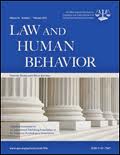Allowing people to consider information about how others view sexual objectification could reduce the influence of gender and attitudes toward sexualization on judgments of sexual harassment. This is the bottom line of a recently published article in Law and Human Behavior. Below is a summary of the research and findings as well as a translation of this research into practice.

The impact of gender and views of sexualization on sexual harassment judgments
The Objective Prong in Sexual Harassment: What Is the Standard?
Author
Richard L. Wiener, University of Nebraska-Lincoln
Trace C. Vardsveen, University of Nebraska-Lincoln
Abstract
In Title VII sexual harassment jurisprudence, U.S. courts use a 2-prong subjective-objective test to determine the viability of a sexual harassment claim: The complainant must show that the employer’s conduct was unwelcome and sufficiently severe or pervasive to alter the conditions of employment and create an abusive working environment because of the complainant’s sex from both the complainant’s perspective (subjective prong) and a reasonable person’s perspective (objective prong). This online study used a diverse national sample (361 MTurk Community Members) to investigate whether people apply the objective prong in a uniform manner, as the law assumes, or show predictable differences. Participants read a vignette about a female interviewee’s allegations of sexual harassment following from severe, mild, or no sexual objectification by a male interviewer during a job interview. The interviewee claimed that she was either harassed or not by the interviewer during the interaction, as well as claiming to enjoy or reject sexualization. Participants made judgments about whether the interviewer’s behavior was sexually harassing from the interviewee’s and a reasonable person’s perspective. Overall, participants’ sex and enjoyment of sexualization moderated their judgments of sexual harassment when considering the situation from both points of view, demonstrating that there is no convergence on a unified standard for evaluating whether specific behavior is sexually harassing. Drawing comparisons to obscenity law, we argue that the use of data to form social fact evidence may help decision makers in hostile work environment cases to apply a more uniform understanding of what is hostile and abusive.
Keywords
sexual harassment, objectification, discrimination, hostile work environment
Summary of the Research
“Hostile work environment sexual harassment law prohibits one worker from subjecting another to an abusive environment provided that the complainant perceives the environment as hostile (i.e., the subjective prong of the test) and a reasonable person in a ‘similar environment under essentially like or similar circumstances’ would also find the working conditions to be hostile or abusive (i.e., the objective prong of the test). The current article argues that the objective prong is susceptible to individual difference factors in a manner similar to the community standard test in federal obscenity law. Obscenity law requires a judgment of whether the objectionable materials appeal to the prurient interest or are patently offensive from the perspective of the community exposed to those materials” (p. 545).
“The purpose of the current study was to examine more closely how evaluators with second hand information about the transpiring events, that is, predictors, respond to experiencer claims that they were the victims of harassment. We wondered whether predictor’s gender and measured ESS [Enjoyment of Sexualization Scale] scores were moderators of their harassment judgments. Treating participants as reasonable persons and asking them to evaluate the environment that the target experienced under essentially like or similar circumstances allowed us to examine the way in which predictors make objective prong judgments, including the role of individual differences. Participants read vignettes that described the Wiener et al. (2013) lab interview in which a male interviewer did or did not sexually objectify a female job candidate, who either did or did not complain that she was harassed. The objectification was either severe, that is, longer in duration or mild, shorter in duration. Finally, we included as a speculative factor a statement expressing whether the experiencer did or did not enjoy being sexualized to test whether the predictor’s own enjoyment of sexualization was as important as the experiencer’s reported enjoyment of sexualization” (p. 547).
“The central question was, how does ‘a reasonable person in a similar environment under essentially like or similar circumstances’ to the experiencer, determine whether the situation described in our vignette was sufficiently severe or pervasive to create a hostile environment? If ordinary people rely upon a unified national community standard, that is, one that does not change with differences in predictor sensitivities toward sexual objectification, then the answer should depend on the level of sexual objectification that the target experiences, whether the target complained about harassment, and perhaps whether the target normally enjoys sexualization. It should not depend upon individual differences among the predictors. We predicted that harassment judgments would be the strongest under severe objectification conditions when the experencer complained of the harassing behavior, as well as when she did not enjoy sexualization. These judgments should be the weakest in the no objectification control condition, when the experiencer does not complain of harassment and when she enjoys sexualization. Thus, a unified community standard would predict main effects of objectification and possibly two-way interactions between that factor and target complaints of harassment, as well as two-way interactions between objectification and target enjoyment of sexualization, factors that depict the objective events in our vignette” (p. 547).
“However, to the extent that individual differences such as gender of the participant and the participant’s own enjoyment of sexualization interact with the severity of objectification, there is evidence that any national community standard breaks down with differences in evaluator sensitivities. If that is the case, then similar to obscenity judgments under federal law, hostile work environment judgments may benefit from empirical evidence demonstrating whether or not a reasonable person would find the complained after behavior harassing. Such evidence could help systematize the community standard. In summary, we posit two opposing hypotheses: Hypothesis 1 (unified national community standard exists) was that there would be main effects on harassment judgments for level of severity of sexual objectification and, perhaps, two-way interactions between objectification and the interviewer’s claim of harassment, as well as her self-reported enjoyment of sexualization. The opposing Hypothesis 2 (no unified national standard exists) predicted that the effect of severity of objectification would emerge, but only some of the time depending upon the participant’s gender and measured enjoyment of sexualization. That is, participant gender and enjoyment of sexualization would trigger predictable sensitivities, such that women would be more sensitive to milder forms of objectification, as would evaluators who did not enjoy sexualization” (p. 547).
“The manipulation of sexual objectification had the intended impact on judgments of interviewer unprofessionalism with participants in the severe objectification condition finding the interviewee to be most unprofessional, followed by those in the mild objectification condition, and then the no objectification control condition. Most interestingly, the difference between the severe and mild condition was significant for men but not for women, suggesting that women found any occurrence of objectification unprofessional while men differentiated according to objectification severity. There are a number of potential reasons why the manipulation behaved differently for men than for women, including greater ability to detect objectification in women, greater sensitivity to the male interviewer’s conduct in men, and gender differences in standards of professional conduct. Although the current data does not allow a complete explanation of these differences, future experimental studies that vary objectification severity in more nuanced ways (e.g., manipulating the content of the comments, using a fuller range of gaze times and manipulating the interviewer’s nonverbal behavior) will be important to understand gender differences in perceived objectification. Finally, the manipulation of the interviewee’s claim was also successful in that participants who read that the interviewee complained that she was harassed rated the interviewer more negatively than did those who read about an interviewee that did not complain” (p. 554).
“With regard to participants’ inferences about the subjective prong of the severe or pervasive test, participants taking the interviewee’s perspective found more evidence of subjective harassment in the severe objectification condition, less in the mild condition and the least in the no objectification condition. However, several factors qualified this finding. First, men discriminated between mild and severe harassment when determining if the interviewee experienced harassment whereas women did not; instead they found any objectification harassing as compared to no objectification. But most interesting was that the participants’ enjoyment of sexualization did not predict their reactions to mild objectification but did predict their reactions to severe objectification. Those who read about severe objectification were less likely to find that the interviewee had experienced legal harassment as their enjoyment of sexualization increased. Furthermore, participants who read that the interviewee claimed that she was harassed found more evidence of subjective harassment than did those who learned that the interviewee did not claim harassment. Nonetheless, the fact that the participants’ own enjoyment of sexualization moderated their evaluations of severe objectification, but that the interviewee’s report of sexualization did not moderate participants’ evaluations of either severe or mild sexual objectification is somewhat disturbing, given that Kimble et al. (2016) found that those experiencers’ responses to actual objectification depended upon the experiencers’ own enjoyment of sexualization. Unbiased predictors ought to consider the experiencer’s level of sexualization enjoyment and not their own, when judging objectification. Thus, although we did not design our experiment to find bias in inferences of subjective harassment, these results suggest that such bias occurred in our participants’ judgments. In other words, when evaluating the subjective prong by determining whether the interviewee experienced harassment, the evaluators should have been more influenced by the interviewee’s enjoyment of sexualization, rather than their own” (p. 554).
“Even though neither the complainant’s own claim of harassment nor her espoused level of enjoyment of sexualization influenced the reasonable person judgments, the objectification effects support Hypothesis 1, suggesting that a unified national standard exists but that reasonable others make that judgment without considering the claims of the target regarding the experience of harassment or her rejection of sexualization. Had we stopped here, this would be the conclusion for the objective prong. However, we found that sex of the participant moderated this effect such that the pattern just discussed described the judgments that reasonable women made but not those of reasonable men. In fact, the men did not show an overall significant difference in legal harassment across the three objectification conditions. This is true even though men were more nuanced than were women when they evaluated the unprofessionalism inherent in sexual objectification. Thus, these data show that sex of the evaluator splinters any unified national standard for sexual harassment, supporting Hypothesis 2” (p. 554).
“Further support for Hypothesis 2, that a unified standard does not naturally exist, comes from the moderating influence of participants’ enjoyment of sexualization on their interpretation of sexual objectification. Although participants found the mild and severe objectification harassing compared to the no objectification controls, the differences deteriorated as participant enjoyment of sexualization increased and finally disappeared at the highest levels of ESS. In the severe condition, those who scored low on the ESS found significant objectification effects on legal harassment but the effect of objectification steadily decreased as scores increased on the ESS. In fact, participants scoring at the 90th ESS percentile, did not find severe objectification harassing as compared to no objectification. A similar pattern, but with slower convergence, emerged in the mild objectification condition, but this time ESS did not moderate those in the objectification condition, but instead moderated those in the control, no objectification condition. Together these findings challenge the existence of a unified standard, which not only breaks down by gender, but further splinters depending upon whether participants do or do not enjoy sexualization. Clearly, these findings draw into question the existence of a unified agreement of the effects of sexual objectification among predictors who ultimately serve as jurors, EEOC officers, and perhaps even judges” (p. 554).
Translating Research into Practice
“Taken together, our findings support Hypothesis 2 and demonstrate specific ways in which sex of the evaluator and enjoyment of sexualization limit the uniformity of a standard for evaluating alleged sexual misconduct. When the courts faced a similar problem for criminal obscenity, that is, when they found the community standard for establishing a prurient interest in sex and a patently offensive view of sex varied according to the sensitivities of the members of the national community, they allowed jurors to hear empirical evidence that assisted them in identifying the community standard as illustrated above in People v. Nelson (1980). Similarly, the current data point to the need for social fact evidence in sexual harassment law. Here, social facts refer to a specialized type of adjudicated fact, that is, facts the jury hears that describe the parties, their activities, their properties or their businesses, which social scientists collect by applying scientific methodologies specific to the issues in a particular case to try and prove some issue in the case. Here, social fact data would be similar to those in obscenity cases that help the trier of fact determine a national community standard, a standard that the ninth circuit already requires in obscenity law when questionable materials are distributed across the Internet” (p. 555-556).
“What would these social facts look like in a sexual harassment case? They would be a collection of judgments about sexual harassment for the specific conduct complained about in a particular case. If the case were about severe sexual objectification, the data would look very much like the results in the current study. That is, an expert would present to the jurors the overall judgment of harassment across levels of objectification as well as the differences that occur as a function of sex and enjoyment of sexualization. The goal would be to assist triers of fact to reach a consensus despite their own individual differences, so that they did not rely on the views of either oversensitive or undersensitive individuals, who very well could be members of the jury. If a case were about other forms of potential harassment, such as name calling, uninvited acts of touching, unreciprocated sexual attention or some combination, then the relevant research would use those circumstances to present judgments made by men and women under varying conditions. As is the case with all social fact data, the jury would retain the final judgment, but under a Daubert or even a Frye admissibility regime, social fact data showing how reasonable people make harassment judgments would need to be relevant, reliable, and helpful to the triers of fact by assisting them to formulate an objective decision that is in compliance with the sufficiently severe or pervasive test. We think the current study makes the need for these types of data clear” (p. 556).
Other Interesting Tidbits for Researchers and Clinicians
“Analysis of objective harassment judgments from the reasonable person perspective (i.e., the objective prong) showed main effects of objectification such that there were higher ratings of objective harassment in both of the objectification conditions as compared to the control, no objectification condition. And yet, these same participants failed to incorporate the interviewee’s claim of whether she was harassed as they interpreted the objectification information. While a single finding does not necessarily point to a policy implication, our results do suggest that predictors may not weigh the experiencers’ perspectives when evaluating objectification. Instead, they seem to rely more on themselves as reference points when forecasting the impact of objectification severity. If this finding replicates, it suggests that predictors (e.g., human resource officials, EEOC officers and jurors) may overestimate the importance of sexual objectification when forecasting the effects of that conduct as they judge harassment. Additional research on this issue will help us understand the impact of sexual objectification when people make harassment judgments” (p. 554-555).
Join the Discussion
As always, please join the discussion below if you have thoughts or comments to add!















